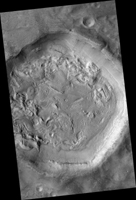
Map Projected Browse Image
Click on image for larger versionThe mid-latitudes of Mars are draped with deposits of water ice and dust on the order of tens of meters thick. The deposits are preserved to varying degrees, depending on latitude and the degree of dust cover that insulates and protects the ice from subliming away.
These mantling deposits are thought to have been mobilized from the polar caps and redeposited from the atmosphere millions of years ago during periods when Mars' axial tilt was higher than it is today.
The floor of this crater appears filled with such deposits, as evidenced by surface textures such as pits, hollows, grooves, and other small filled craters. The material has undergone viscous flow, resulting in many curved ridges. Much of the original ice may have been lost to sublimation, but it is likely that a significant amount of ice remains.
The map is projected here at a scale of 25 centimeters (9.8 inches) per pixel. (The original image scale is 29.6 centimeters [11.7 inches] per pixel [with 1 x 1 binning]; objects on the order of 89 centimeters [35.0 inches] across are resolved.) North is up.
The University of Arizona, in Tucson, operates HiRISE, which was built by Ball Aerospace & Technologies Corp., in Boulder, Colorado. NASA's Jet Propulsion Laboratory, a division of Caltech in Pasadena, California, manages the Mars Reconnaissance Orbiter Project for NASA's Science Mission Directorate, Washington.

